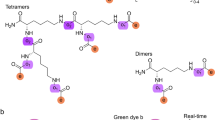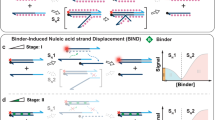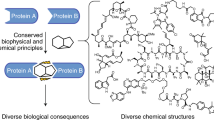Abstract
The residence time of a drug on its target has been suggested as a more pertinent metric of therapeutic efficacy than the traditionally used affinity constant. Here, we introduce junctured-DNA tweezers as a generic platform that enables real-time observation, at the single-molecule level, of biomolecular interactions. This tool corresponds to a double-strand DNA scaffold that can be nanomanipulated and on which proteins of interest can be engrafted thanks to widely used genetic tagging strategies. Thus, junctured-DNA tweezers allow a straightforward and robust access to single-molecule force spectroscopy in drug discovery, and more generally in biophysics. Proof-of-principle experiments are provided for the rapamycin-mediated association between FKBP12 and FRB, a system relevant in both medicine and chemical biology. Individual interactions were monitored under a range of applied forces and temperatures, yielding after analysis the characteristic features of the energy profile along the dissociation landscape.
This is a preview of subscription content, access via your institution
Access options
Access Nature and 54 other Nature Portfolio journals
Get Nature+, our best-value online-access subscription
$29.99 / 30 days
cancel any time
Subscribe to this journal
Receive 12 print issues and online access
$259.00 per year
only $21.58 per issue
Buy this article
- Purchase on Springer Link
- Instant access to full article PDF
Prices may be subject to local taxes which are calculated during checkout





Similar content being viewed by others
Data availability
The data that support the plots within this paper and other findings of this study are available from the corresponding authors upon reasonable request.
References
Rognoni, L., Stigler, J., Pelz, B., Ylanne, J. & Rief, M. Dynamic force sensing of filamin revealed in single-molecule experiments. Proc. Natl Acad. Sci. USA 109, 19679–19684 (2012).
Kim, J., Zhang, C.-Z., Zhang, X. & Springer, T. A. A mechanically stabilized receptor–ligand flex-bond important in the vasculature. Nature 466, 992–995 (2010).
Marshall, B. T. et al. Direct observation of catch bonds involving cell-adhesion molecules. Nature 423, 190–193 (2003).
Copeland, R. A. The drug-target residence time model: a 10-year perspective. Nat. Rev. Drug Disc. 15, 87–95 (2016).
Schuetz, D. A. et al. Kinetics for drug discovery: an industry-driven effort to target drug residence time. Drug Disc. Today 22, 896–911 (2017).
Swinney, D. C. Applications of binding kinetics to drug discovery. Curr. Opin. Pharm. Med. 22, 23–34 (2008).
Fang, Y. Ligand-receptor interaction platforms and their applications for drug discovery. Expert Opin. Drug. Discov. 7, 969–988 (2012).
Burnouf, D. et al. kinITC: a new method for obtaining joint thermodynamic and kinetic data by isothermal titration calorimetry. J. Am. Chem. Soc. 134, 559–565 (2012).
Eccleston, J. F., Martin, S. R. & Schilstra, M. J. Rapid kinetic techniques. Methods Cell Biol. 84, 445–477 (2008).
Garcia-Manyes, S. & Beedle, A. E. M. Steering chemical reactions with force-dependent. Nat. Rev. Chem. 1, 83 (2017).
Sellers, J. R. & Veigel, C. Direct observation of the myosin-Va power stroke and its reversal. Nat. Struct. Mol. Biol. 17, 590–595 (2010).
Hall, M. A. et al. High-resolution dynamic mapping of histone–DNA interactions in a nucleosome. Nat. Struct. Mol. Biol. 16, 124–129 (2009).
Kilcherr, F. et al. Single-molecule dissection of stacking forces in DNA. Science 353, aaf5508 (2016).
Schoeler, C. et al. Mapping mechanical force propagation through biomolecular complexes. Nano Lett. 15, 7370–7376 (2015).
Gao, Y. et al. Single reconstituted neuronal SNARE complexes zipper in three distinct stages. Science 337, 1340–1343 (2012).
Dietz, H., Berkemeier, F., Bertz, M. & Rief, M. Anisotropic deformation response of single protein molecules. Proc. Natl Acad. Sci. USA 103, 12724–12728 (2006).
Wang, J. L. et al. Dissection of DNA double-strand-break repair using novel single-molecule forceps. Nat. Struct. Mol. Biol. 25, 482–487 (2018).
Halvorsen, K., Schaak, D. & Wong, W. P. Nanoengineering a single-molecule mechanical switch using DNA self-assembly. Nanotechnology 22, 494005 (2011).
Johnson, K. C. & Thomas, W. E. How do we know when single-molecule force spectroscopy really tests single bonds? Biophys. J. 114, 2032–2039 (2018).
Koirala, D. et al. Single-molecule mechanochemical sensing using DNA origami nanostructues. Angew. Chem. Int. Ed. 53, 8137–8141 (2014).
Nickels, P. C. et al. Molecular force spectroscopy with a DNA origami-based nanoscopic force clamp. Science 354, 305–307 (2016).
Bouchiat, C. et al. Estimating the persistence length of a worm-like chain molecule from force–extension measurements. Biophys. J. 76, 409–413 (1999).
Ribeck, N. & Saleh, O. A. Multiplexed single-molecule measurements with magnetic tweezers. Rev. Sci. Instrum. 79, 094301 (2008).
De Vlaminck, I. et al. Highly parallel magnetic tweezers by targeted DNA tethering. Nano Lett. 11, 5489–5493 (2011).
Liu, F., Wang, Y.-Q., Meng, L., Gu, M. & Tan, R.-Y. FK506-binding protein 12 ligands: a patent review. Expert Opin. Ther. Pat. 23, 1435–1449 (2013).
Benjamin, D., Colombi, M., Moroni, C. & Hall, M. N. Rapamycin passes the torch: a new generation of mTOR inhibitors. Nat. Rev. Drug Discov. 10, 868–880 (2011).
Putyrski, M. & Schultz, C. Protein translocation as a tool: the current rapamycin story. FEBS Lett. 586, 2097–2105 (2012).
Voss, S., Klewer, L. & Wu, Y.-W. Chemically induced dimerization: reversible and spatiotemporal control of protein function in cells. Curr. Opin. Chem. Biol. 28, 194–201 (2015).
Banaszynski, L. A., Liu, C. W. & Wandless, T. J. Characterization of the FKBP–rapamycin–FRB ternary complex. J. Am. Chem. Soc. 127, 4715–4721 (2005).
Bierer, B. E. et al. Two distinct signal transmission pathways in lymphocytes-T are inhibited by complexes formed between an immunophilin and either FK506 or rapamycin. Proc. Natl Acad. Sci. USA 87, 9231–9235 (1990).
Wear, M. A. & Walkinshaw, M. D. Determination of the rate constants for the FK506 binding protein/rapamycin interaction using surface plasmon resonance: an alternative sensor surface for Ni2+-nitrilotriacetic acid immobilization of His-tagged proteins. Anal. Biochem. 371, 250–252 (2007).
Kozany, C., Marz, A., Kress, C. & Hausch, F. Fluorescent probes to characterise FK506-binding proteins. Chembiochem 10, 1402–1410 (2009).
Tamura, T., Kioi, Y., Miki, T., Tsukiji, S. & Hamachi, I. Fluorophore labeling of native FKBP12 by ligand-directed tosyl chemistry allows detection of its molecular interactions in vitro and in living cells. J. Am. Chem. Soc. 135, 6782–6785 (2013).
Lu, C. & Wang, Z. X. Quantitative analysis of ligand induced heterodimerization of two distinct receptors. Anal. Chem. 89, 6926–6930 (2017).
Chin, J. W. et al. Addition of p-azido-l-phenylalanine to the genetic code of Escherichia coli. J. Am. Chem. Soc. 124, 9026–9027 (2002).
Duboc, C., Fan, J., Graves, E. T. & Strick, T. R. Preparation of DNA substrates and functionalized glass surfaces for correlative nanomanipulation and colocalization (NanoCOSM) of single molecules. Methods Enzymol. 582, 275–296 (2017).
Schlierf, M., Li, H. & Fernandez, J. M. The unfolding kinetics of ubiquitin captured with single-molecule force–clamp techniques. Proc. Natl Acad. Sci. USA 101, 7299–7304 (2004).
Evans, E. Probing the relation between force—lifetime—and chemistry in single molecular bonds. Annu. Rev. Biophys. Biomol. Struct. 30, 105–128 (2001).
Popa, I., Fernandez, J. M. & Garcia-Manyes, S. Direct quantification of the attempt frequency determining the mechanical unfolding of ubiquitin protein. J. Biol. Chem. 286, 31072–31079 (2011).
Brockwell, D. J. et al. Pulling geometry defines the mechanical resistance of a β-sheet protein. Nat. Struct. Biol. 10, 731–737 (2003).
Carrion-Vazquez, M. et al. The mechanical stability of ubiquitin is linkage dependent. Nat. Struct. Biol. 10, 738–743 (2003).
Jagannathan, B., Elms, P. J., Bustamante, C. & Marqusee, S. Direct observation of a force-induced switch in the anisotropic mechanical unfolding pathway of a protein. Proc. Natl Acad. Sci. USA 109, 17820–17825 (2012).
Ainavarapu, S. R. K., Wiita, A. P., Dougan, L., Uggerud, E. & Fernandez, J. M. Single-molecule force spectroscopy measurements of bond elongation during a bimolecular reaction. J. Am. Chem. Soc. 130, 6479–6487 (2008).
Choi, J. W., Chen, J., Schreiber, S. L. & Clardy, J. Structure of the FKBP12–rapamycin complex interacting with the binding domain of human FRAP. Science 273, 239–242 (1996).
DeCenzo, M. T. et al. FK506-binding protein mutational analysis: defining the active-site residue contributions to catalysis and the stability of ligand complexes. Protein Eng. 9, 173–180 (1996).
Leone, M. et al. The FRB domain of mTOR: NMR solution structure and inhibitor design. Biochemistry 45, 10294–10302 (2006).
Keppler, A. et al. Labeling of fusion proteins of O6-alkylguanine-DNA alkyltransferase with small molecules in vivo and in vitro. Methods 32, 437–444 (2004).
Hinner, M. J. & Johnsson, K. How to obtain labeled proteins and what to do with them. Curr. Opin. Biotechnol. 21, 766–776 (2010).
Gautier, A. et al. An engineered protein tag for multiprotein labeling in living cells. Chem. Biol. 15, 128–136 (2008).
Allemand, J.-F., Cocco, S., Douarche, N. & Lia, G. Loops in DNA: an overview of experimental and theoretical approaches. Eur. Phys. J. E 19, 293–302 (2006).
Bier, D., Thiel, P., Briels, J. & Ottmann, C. Stabilization of protein–protein interactions in chemical biology and drug discovery. Prog. Biophys. Mol. Biol. 119, 10–19 (2015).
Neklesa, T. K., Winkler, J. D. & Crews, C. M. Targeted protein degradation by PROTACs. Pharmacol. Ther. 174, 138–144 (2017).
Roy, M. J. et al. SPR-measured dissociation kinetics of PROTAC ternary complexes influence target degradation rate. ACS Chem. Biol. 14, 361–368 (2019).
Del Bano, J., Chames, P., Baty, D. & Kerfelec, B. Taking up cancer immunotherapy challenges: bispecific antibodies, the path forward? Antibodies 5, 23 (2016).
Keppler, A. et al. A general method for the covalent labeling of fusion proteins with small molecules in vivo. Nat. Biotechnol. 21, 86–89 (2003).
Revyakin, A., Ebright, R. H. & Strick, T. R. DNA nanomanipulation: improved resolution through use of shorter DNA fragments. Nat. Methods 2, 127–138 (2005).
Strick, T. R., Allemand, J. F., Bensimon, D., Bensimon, A. & Croquette, V. The elasticity of a single supercoiled DNA molecule. Science 271, 1835–1837 (1996).
Gosse, C. & Croquette, V. Magnetic tweezers: micromanipulation and force measurement at the molecular level. Biophys. J. 82, 3314–3329 (2002).
Acknowledgements
This work was supported by the grants T-DropTwo (Labex NanoSaclay), T-DropThree (Idex Paris-Saclay), NanoRep (PSL University), Gephyrip (Labex Memolife) and J-DNA (PSL-Valorisation). T.R.S. is part of the ‘Equipe Labellisée’ program of the Ligue Nationale Contre la Cancer. H.K.W.-S. and J.L.W., respectively, acknowledge the National Science Foundation and the China Scholarship Council for PhD fellowships. We thank A. Thomas and L. Friedman for the preliminary experiments, as well as the groups of J. Yan and F. Hausch for discussions on unpublished data.
Author information
Authors and Affiliations
Contributions
D.K., T.R.S. and C.G. conceived the experiments, J.L.W. contributed unique reagents, D.K. and M.F. prepared reagents and carried out measurements, D.K. and T.R.S. carried out primary data analysis, D.K., H.K.W.-S., V.S.P., T.R.S. and C.G. carried out advanced data analysis and modelling and D.K., T.R.S. and C.G. wrote the paper.
Corresponding authors
Ethics declarations
Competing interests
The authors declare no competing interests.
Additional information
Peer review information Nature Nanotechnology thanks Michael Schlierf and the other, anonymous, reviewer(s) for their contribution to the peer review of this work.
Publisher’s note Springer Nature remains neutral with regard to jurisdictional claims in published maps and institutional affiliations.
Supplementary information
Supplementary information
Supplementary Figs. 1–9, Tables 1 and 2, Methods and Refs. 1–25.
Rights and permissions
About this article
Cite this article
Kostrz, D., Wayment-Steele, H.K., Wang, J.L. et al. A modular DNA scaffold to study protein–protein interactions at single-molecule resolution. Nat. Nanotechnol. 14, 988–993 (2019). https://doi.org/10.1038/s41565-019-0542-7
Received:
Accepted:
Published:
Issue Date:
DOI: https://doi.org/10.1038/s41565-019-0542-7
This article is cited by
-
Single-molecule force stability of the SARS-CoV-2–ACE2 interface in variants-of-concern
Nature Nanotechnology (2024)
-
Quantifying postsynaptic receptor dynamics: insights into synaptic function
Nature Reviews Neuroscience (2023)
-
Single-molecule mechanical fingerprinting with DNA nanoswitch calipers
Nature Nanotechnology (2021)
-
Single-molecule kinetic locking allows fluorescence-free quantification of protein/nucleic-acid binding
Communications Biology (2021)



